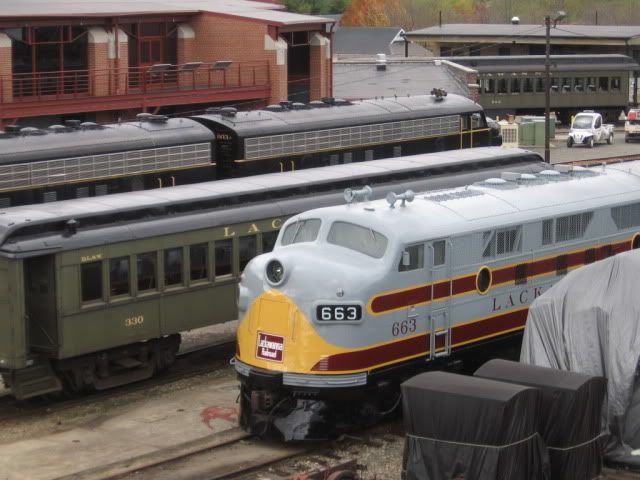can someone provide me a definative visual discriptive answer as how to define an f3 from an f7 loco? where is the difference ? thanks, paul.
Original Post
|




|
Replies sorted oldest to newest













quote:Originally posted by SB..:
Wikipedia: There are no easily identifiable differences between late F3 production and early F7 production; the major differences were all internal electrical system changes. However, no F7 had the “chicken wire” grilles of most F3s.

quote:The Williams F3's have the low fans and side louvers and lack of chicken wire on the side as on an F7, yet have no stainless side grills. Does this make them F7's?
quote:What about the DB's? The Williams models do not have DB fans, but rooftop "screens"...
quote:Originally posted by VaGolfer1950:quote:The Williams F3's have the low fans and side louvers and lack of chicken wire on the side as on an F7, yet have no stainless side grills. Does this make them F7's?
Naw just a not accurately done model. Kind of normal for our hobby.
quote:Good enough for the 1950's, good enough for nostalgia. Way off the mark for a full scale model.
Rusty




quote:the F7 DB fan was placed under the original roof screening with what appears to be a sheet metal frame welded under the rest of the screening
quote:Originally posted by gftiv:
This is how I tell the difference between a F3 and a F7. I read the flap on the end of the box.
quote:I read the flap on the end of the box.
quote:Originally posted by marker:quote:the F7 DB fan was placed under the original roof screening with what appears to be a sheet metal frame welded under the rest of the screening
Now that is amazing. They must have really appreciated their F3, or it was a cost saving move. I wonder which.
quote:Originally posted by poppyl:quote:Originally posted by marker:quote:the F7 DB fan was placed under the original roof screening with what appears to be a sheet metal frame welded under the rest of the screening
Now that is amazing. They must have really appreciated their F3, or it was a cost saving move. I wonder which.
I'd say "cost saving" since they never purchased another F3 and instead went with F7's. Cheaper to modify the existing units rather than trade-in and buy new. Also, WM may have gotten a good deal from EMD since they were in the process of procuring a bunch of F7's. Standardization around the F7 probably brought other operational and maintenance economies, too.
Poppyl
quote:Originally posted by CentralFan1976:
They were either horizontal or vertical grills (Farr). Which came first, the vertical Farr-type or the horizontal?
Thanks,
Mario
quote:Originally posted by DominicMazoch:
Now hy did EMD equip the D/B on the 3 with the slits for coolong, instead of a fan as in the later units?
quote:Originally posted by SB..:
Wikipedia: There are no easily identifiable differences between late F3 production and early F7 production; the major differences were all internal electrical system changes. However, no F7 had the “chicken wire” grilles of most F3s.
Lots of F3's had the near flush-mount fans on top.
Wikipedia: F3 Phase II (late)
Built from December 1947. Roof radiator fans change to low, pan-topped items.

quote:Originally posted by SB..:
Yes, but dynamic brake slits are also found on F2 & F5.
So it seems the only reliable tells are specifically for the F3 & F2. If it has chicken-wire side between 2 port-holes, it's definitely an F3. If it has 3 port-holes and tiny FT number-boards, it's definitely an F2. If it doesn't have any of those, then there is no external way to be certain (as many F7+ pars were retro-fitted onto older models).
Access to this requires an OGR Forum Supporting Membership
